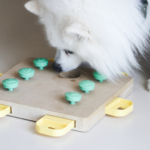Introduction
In the world of our four-legged companions, boredom can lead to a range of behavioral issues. This article delves into the importance of recognizing and addressing canine boredom, offering insights into its causes and practical solutions for a happier and more engaged furry friend.
The Roots of Canine Boredom
Canine boredom is more than just a restless pup; it can lead to a spectrum of behavioral issues. Recognizing the roots of boredom is crucial for a fulfilling and contented life for your furry friend.
Dogs are intelligent beings with a need for mental challenges. A lack of mental stimulation can result in boredom, leading to undesirable behaviors. Ensure your dog’s environment includes activities that engage their minds, such as puzzle toys, interactive games, or training sessions. Rotate toys regularly to keep the novelty alive.
One of the primary causes of canine boredom is a lack of physical exercise. Dogs, regardless of breed or size, need regular physical activities to expend energy and stimulate their bodies. Daily walks, play sessions, or even agility exercises are essential to keep boredom at bay. Tailor the activities to your dog’s breed and energy level for maximum impact.
Dogs are social creatures, and loneliness can contribute significantly to boredom. If your furry friend spends extended periods alone, boredom may set in. Consider arranging playdates, hiring a dog walker, or providing interactive toys to alleviate loneliness. Ensuring your dog has companionship and social interaction can significantly reduce boredom-related issues.
Understanding Canine Communication
Dogs are experts at non-verbal communication, and they express their emotions through a range of subtle cues. Recognizing these signals is crucial to understanding when your furry friend might be experiencing boredom or stress.
One common sign of boredom is excessive licking or chewing, often directed towards themselves. If your dog is engaging in constant self-grooming, it might indicate a lack of mental stimulation. Similarly, yawning when not tired or in response to environmental stimuli can signal stress. Keep an eye on these behaviors, especially if they occur in unusual contexts.
Changes in posture can also be indicative of your dog’s emotional state. A slouched or hunched stance might suggest discomfort or stress, while a rigid body and raised hackles could signal anxiety or excitement. Monitor their body language during various activities to pinpoint potential stressors.
Vocalizations, such as whining or excessive barking, are classic signs of distress or boredom. While occasional barking is normal, persistent vocalizations, especially in the absence of apparent stimuli, may indicate a need for mental or physical stimulation.
Identifying Boredom-Induced Issues
Canine boredom isn’t merely a passing phase; it can manifest in various behavioral problems that challenge both the dog and its owner. Understanding the potential consequences is crucial for addressing and preventing these issues.
Excessive barking is a common behavioral problem stemming from boredom. When dogs lack mental and physical stimulation, they may resort to barking as a way to express frustration or seek attention. This not only disrupts the household but can also lead to strained relationships with neighbors.
Destructive chewing is another common fallout of canine boredom. Dogs left to their own devices without proper mental engagement may resort to chewing furniture, shoes, or household items. This destructive behavior is often a coping mechanism for the stress and restlessness associated with boredom.
Attention-seeking behaviors can become a challenging aspect of boredom-related problems. Dogs crave interaction and mental stimulation; when deprived of these, they may seek attention through undesirable means. This can include pawing, nudging, or even more intrusive behaviors, disrupting the owner’s peace and potentially causing frustration.
Practical Solutions for Mental Stimulation
Keeping your dog mentally stimulated is just as important as providing physical exercise. Without mental challenges, dogs can become bored and restless, leading to undesirable behaviors. Here are some engaging activities to keep your dog’s mind sharp and active.
Puzzle toys are an excellent way to provide mental stimulation for your dog. These toys typically involve hiding treats or kibble inside compartments that your dog must figure out how to access. This engages their problem-solving skills and keeps them entertained as they work to uncover the tasty reward.
Interactive games offer another avenue for mental stimulation. Games like hide-and-seek or treasure hunt encourage your dog to use their senses and cognitive abilities to locate hidden objects or treats. These activities provide mental challenges while also strengthening the bond between you and your dog.
Training sessions are not only beneficial for teaching your dog new skills but also for keeping their mind engaged. Training exercises require focus, attention, and problem-solving, all of which are mentally stimulating for your furry friend. Plus, learning new commands or tricks provides a sense of accomplishment for your dog, boosting their confidence and mental well-being.
Enhancing Physical Activities
Regular exercise is a cornerstone in ensuring your dog’s physical and mental well-being. Beyond keeping them physically fit, consistent exercise plays a crucial role in preventing boredom and associated behavioral issues. Let’s delve into the significance of incorporating regular exercise into your dog’s routine.
Dogs, by nature, are active animals with a natural instinct to move and explore. Regular exercise not only helps them burn off excess energy but also stimulates their minds. Engaging in physical activities like walks, runs, or play sessions provides an outlet for their natural instincts, reducing the likelihood of boredom.
Boredom in dogs can manifest in various ways, from excessive barking to destructive behaviors. Regular exercise acts as a powerful deterrent against these unwanted habits. It offers an opportunity for mental stimulation, keeping your dog’s brain active and preventing the restlessness that can lead to behavioral issues.
Additionally, exercise is a fantastic way to strengthen the bond between you and your furry companion. Shared activities like fetch, agility training, or even a simple game of tug-of-war create positive interactions and contribute to a harmonious relationship.
Tailoring your dog’s exercise routine to their breed, age, and health status is key. Whether it’s a brisk walk, a game of fetch, or agility exercises, finding activities that suit your dog’s preferences ensures they stay physically and mentally engaged. Regular exercise not only wards off boredom but also promotes a happy, healthy, and well-balanced canine companion.
Creating an Enriched Environment
Your dog’s living space plays a pivotal role in their overall well-being, influencing everything from physical health to mental stimulation. Designing an enriched living space involves considering various aspects that contribute to your dog’s happiness and contentment.
Start by ensuring your dog has access to safe and secure outdoor areas. Dogs thrive on fresh air, sunlight, and the opportunity to explore their surroundings. A fenced yard or designated play area not only provides physical exercise but also allows your dog to indulge their natural instincts.
Comfortable resting spots are equally crucial. Dogs, much like humans, appreciate a cozy place to relax. Invest in comfortable bedding or create designated resting areas in different parts of your home. This ensures your dog has options and can choose a spot that suits their mood, whether it’s a sunny corner or a quiet nook.
Interactive play zones add an extra layer of enrichment to your dog’s living space. Toys, puzzle feeders, and interactive games engage their minds, preventing boredom and fostering mental stimulation. Rotate toys regularly to keep things interesting, and consider incorporating activities that tap into their innate instincts, like hide-and-seek or scent-based games.
Conclusion
In conclusion, understanding and addressing canine boredom are pivotal for a harmonious relationship with your furry companion. By incorporating mental stimulation, physical activities, and an enriched environment, you pave the way for a happy and contented tail-wagger.









